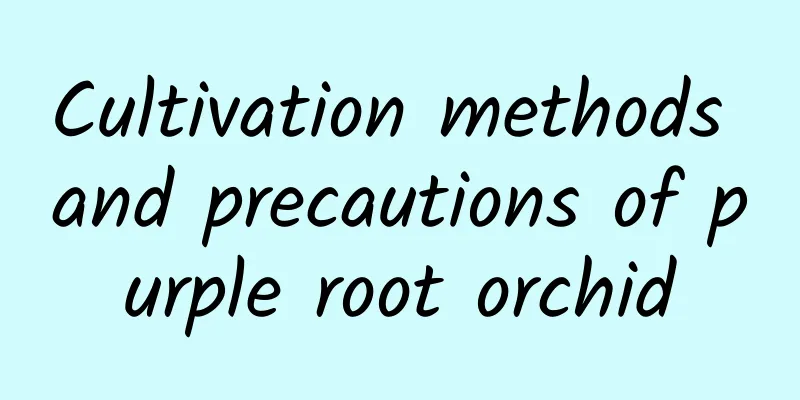Cultivation methods and precautions of purple root orchid

|
Purple root orchid is actually a very easy to grow flower plant. As long as you care for it carefully in the correct way, you will be fine. Generally, you should pay attention to fertilizing the purple root orchid properly, because purple root orchid is a plant that likes fertilizer very much. During the breeding period, it is most appropriate to apply a thin phosphorus fertilizer to the purple root orchid once a month. Be careful not to apply too much fertilizer, otherwise it will easily hinder the growth of purple root orchid. How to grow purple orchid1. Soil Before caring for purple root orchid, we must choose a soil suitable for its growth as a medium. Generally speaking, it is best to choose sandy soil with good drainage and rich in organic matter and humus, which can fully meet the nutrient needs of purple root orchid. 2. Watering Purple root orchid does not require much water. Generally, it only needs to be watered thoroughly every 10-15 days. Be careful not to cause water accumulation in the pot to avoid waterlogging and root rot. This will promote the differentiation of flower buds and allow it to bloom better. 3. Lighting Purple root orchid is a plant that likes sunlight, so it should be placed in a well-lit place for cultivation, but be careful not to place the light too strong. Wait until the sunlight is mild before placing it outdoors for exposure. After summer, it is necessary to provide appropriate shade to avoid burning the leaves due to excessive light. 4. Temperature For purple root orchid, 18-25 degrees Celsius is its best cultivation temperature, which can promote its better growth. If it enters winter, avoid keeping purple root orchid in an environment below 5 degrees Celsius to prevent frost damage. Purple root orchid care precautions1. Reasonable pruning When the purple root orchid is in the growth period, it is necessary to carry out reasonable pruning regularly, cut off the weak and diseased branches, and clean up the withered and necrotic purple root orchids, otherwise a series of disease problems will occur because of them. 2. Timely prevention of damage If the purple root orchid cannot be prevented and controlled in time for diseases and pests, it will grow more and more crooked. For the insects that accompany the purple root orchid, you can use tools to clean them or spray them with medicine to prevent insects. |
<<: Advantages and disadvantages of Abans roses
>>: Advantages and disadvantages of Pinka climbing rose
Recommend
Is Brazilian iris poisonous?
Is Brazilian iris poisonous? The Brazilian iris i...
How to deal with the cut-off seedlings of African violets
Treatment methods for African violet beheaded see...
Where is the ginkgo tree suitable for growing? What are its growth environment and growth characteristics?
Where do Ginkgo trees grow? Ginkgo trees are suit...
Can Gloxinia be poured with beer?
Can Gloxinia be watered with beer water? Generall...
How to grow Forsythia in autumn
1. Scientific fertilization Autumn is the time wh...
Why Phalaenopsis orchids drop their buds
1. Excessive nitrogen fertilizer Cause: Phalaenop...
These 4 flowers show the emperor's temperament
King protea The king protea, also known as the Pu...
How to prune pepper tree
When to prune pepper trees Pepper tree can genera...
Growth environment conditions and characteristics of fortune tree
Environmental conditions and requirements for the...
How to water orchids
Tips for watering orchids Generally speaking, it ...
Growing environment conditions and characteristics of crabapple trees
Growing environment conditions and requirements o...
Which flowers are suitable for cuttings in autumn?
Osmanthus fragrans In the romantic month of Augus...
What is the meaning of carnations and who should they be given as gifts?
1. Pink Pink usually represents cuteness and tend...
Reasons and prevention methods of the failure of Euphorbia obliqua to bloom
Lack of light If the flowerpot of Euphorbia obesa...
How to plant longan seeds
The soil for planting longan seeds can be selecte...









